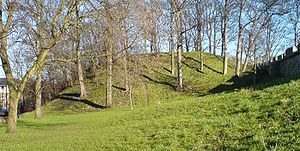
Baile Hill, York
Encyclopedia

York
York is a walled city, situated at the confluence of the Rivers Ouse and Foss in North Yorkshire, England. The city has a rich heritage and has provided the backdrop to major political events throughout much of its two millennia of existence...
, United Kingdom
United Kingdom
The United Kingdom of Great Britain and Northern IrelandIn the United Kingdom and Dependencies, other languages have been officially recognised as legitimate autochthonous languages under the European Charter for Regional or Minority Languages...
. It is the only remaining feature of what was known as the Old Baile.
The origins of Baile Hill date back to 1068. Having seized York in that year, William the Conqueror built a castle
Castle
A castle is a type of fortified structure built in Europe and the Middle East during the Middle Ages by European nobility. Scholars debate the scope of the word castle, but usually consider it to be the private fortified residence of a lord or noble...
on the south side of the city close to the river Ouse
River Ouse, Yorkshire
The River Ouse is a river in North Yorkshire, England. The river is formed from the River Ure at Cuddy Shaw Reach near Linton-on-Ouse, about 6 miles downstream of the confluence of the River Swale with the River Ure...
. Then, as a response to a rebellion the following year, a second castle was built on the opposite side of the river. There is no clear evidence which of these castles was built first, but it is generally thought to be the one which stood on the site of the later York Castle
York Castle
York Castle in the city of York, England, is a fortified complex comprising, over the last nine centuries, a sequence of castles, prisons, law courts and other buildings on the south side of the River Foss. The now-ruinous keep of the medieval Norman castle is sometimes referred to as Clifford's...
on the east side of the river, followed by the Old Baile on the west side.
Like its opposite counterpart, the Old Baile was of motte and bailey design. The motte was approximately 40 feet (12 m) high and 180 feet (66 m) in diameter, and was surrounded by a large ditch. A flight of steps led to a wooden structure at the top which was surrounded by a fence, also made of wood. The bailey lay to the north west of the motte and was rectangular. Around its perimeter was an earth rampart and an outer ditch.
The castle, it is believed, was not in regular use for long. By the 13th century it was in the hands of the Archbishop of York
Archbishop of York
The Archbishop of York is a high-ranking cleric in the Church of England, second only to the Archbishop of Canterbury. He is the diocesan bishop of the Diocese of York and metropolitan of the Province of York, which covers the northern portion of England as well as the Isle of Man...
and in 1322 Archbishop Melton
William Melton
-Life:Melton was the son of Henry of Melton, and the brother of Henry de Melton. He was born in Melton in the parish of Welton, about nine miles from Kingston upon Hull. He was a contemporary of John Hotham, Chancellor of England and Bishop of Ely...
agreed to defend it in times of war. By c.1340 part of the city wall
York city walls
The English city of York has, since Roman times, been defended by walls of one form or another. To this day, substantial portions of the walls remain, and York has more miles of intact wall than any other city in England...
had been built along the southeast and southwest sides of the Old Baile, incorporating the existing ramparts and ditch, however, these defences were rarely called into use. The only notable occasion was the siege of York
Siege of York
The Siege of York in 1644 was a prolonged contest for York during the English Civil War, between the Scottish Covenanter Army and the Parliamentarian Armies of the Northern Association and Eastern Association on the one hand, and the Royalist Army under the Marquess of Newcastle on the other...
in 1644 during the Civil War
English Civil War
The English Civil War was a series of armed conflicts and political machinations between Parliamentarians and Royalists...
, when Baile Hill was used as a royalist
Cavalier
Cavalier was the name used by Parliamentarians for a Royalist supporter of King Charles I and son Charles II during the English Civil War, the Interregnum, and the Restoration...
gun emplacement. Apart from that, however, the Old Baile was used mainly for grazing and recreation activities, particularly archery
Archery
Archery is the art, practice, or skill of propelling arrows with the use of a bow, from Latin arcus. Archery has historically been used for hunting and combat; in modern times, however, its main use is that of a recreational activity...
during the medieval period.
Today, Baile Hill stands at the junction of Baile Hill Terrace and Cromwell Road. The only other visible evidence of the former castle are two slight dips in the city wall rampart, one next to Baile Hill and the other close to Victoria Bar, which indicate the location of the former ditch. Houses built during the 1880’s cover the rest of the Old Baile.

